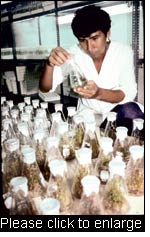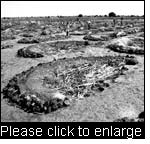InfoResources
News No 5 / 06 (November 2006)
Special feature
> Plant
genetic resources: A valuable asset
Policy
> Shifting cultivation
creates forests
> Forest governance
and decentralisation in Asia and the Pacific
> Soils on the global agenda
Implementation
> Strengthening
the market position of African farmers
> Small-scale
farmers discuss their visions for the future
> A drought insurance
for Amelia Rodriguez
> Review of
protected area finance
> Forest decentralisation
in Latin America: exclusive or inclusive?
Research
>
Technology transfer is a good thing, but...
> Climate and
the media in developing countries
Special Feature
Plant genetic resources: A valuable asset
 The
question of how we handle the world’s genetic resources has been
an important issue in international policy discussions ever since the
launching of the Convention on Biological Diversity, if not earlier.
In principle, sovereignty over genetic resources is in the hands of
the states. However, the Biodiversity Convention demands that genetic
resources be conserved and used in a sustainable manner, and that benefits
arising from this use be equitably distributed. The
question of how we handle the world’s genetic resources has been
an important issue in international policy discussions ever since the
launching of the Convention on Biological Diversity, if not earlier.
In principle, sovereignty over genetic resources is in the hands of
the states. However, the Biodiversity Convention demands that genetic
resources be conserved and used in a sustainable manner, and that benefits
arising from this use be equitably distributed.
The International Treaty on Plant Genetic Resources for Food and
Agriculture (ITPGRFA) has put these demands into concrete terms
with regard to agricultural crops. It stipulates measures to ensure
protection and sustainable use of plant genetic resources and calls
on states to recognise Farmers’ Rights. In particular, the ITPGRFA
regulates the use of the genetic resources of 64 important crops: on
the one hand, it facilitates access to these resources, and on the other
hand, it envisages information exchange, technology transfer, training
and financial compensations to ensure fair and equitable sharing of
the benefits arising out of their use.
In mid June 2006, the ITPGRFA Governing Body adopted important measures
regarding the concrete implementation of the treaty. In particular,
it established the conditions that are to govern the relations between
providers and recipients of genetic resources. For example, 1.1% of
the profit resulting from commercialisation of a product based on these
resources must flow into a fund for the support of rural development
managed by the ITPGRFA Governing Body.
This is a first step towards eliminating the imbalance between poor
rural populations in developing countries with abundant resources, on
the one hand, and business corporations from wealthy industrial nations
that derive profit from these resources, on the other hand. A book entitled
Rights to Plant Genetic Resources and Traditional Knowledge
argues that various further steps are needed. Among other things, the
authors recommend that international law be developed so as to generally
improve the protection of developing countries against abusive exploitation
of their plant genetic resources. The authors also suggest the introduction
of so-called Traditional Intellectual Property Rights to protect
population groups’ traditional knowledge about the use of genetic
resources – an issue not covered by existing intellectual property
rights. The proposed rights would close this gap and thereby counterbalance
well-developed patent protection mechanisms as they exist, for example,
in biotechnology.
The significance of traditional knowledge about genetic resources could
also be enhanced by making special promotion efforts for products based
on them. Geographical indications, labelling, or trade policy measures
such as preferential tariffs could contribute to this aim.
While the quoted measures do have a potential for contributing decisively
to a more equitable use of genetic resources and traditional knowledge,
their implementation takes time. However, concrete regulations already
do exist, as is shown in a brochure entitled Access and Benefit
Sharing: Good practice for academic research on genetic resources.
This publication is intended to inform the scientific community about
existing regulations in the Biodiversity Convention that must be observed
when accessing genetic resources for research purposes. Enriched with
practical examples, the brochure contains step-by-step instructions
on how to plan a project.
If we want to conserve biological diversity and access to genetic resources
in the long term, we must acknowledge the important role that rural
communities in developing countries play in this issue.
Sources:
> Summary of the First Session of the Governing Body of the International
Treaty on Plant Genetic Resources for Food and Agriculture: 12–16
June 2006. Earth Negotiations Bulletin Vol. 9 No. 369. International
Institute for Sustainable Development (IISD). 14 p.
www.iisd.ca/download/pdf/enb09369e.pdf
Daily reports available in English, French and Spanish:
www.iisd.ca/biodiv/itpgrgb1/
> Report of the First Session of the Governing Body of the International
Treaty on Plant Genetic Resources for Food and Agriculture. Madrid,
Spain, 12–16 June 2006. FAO. 177p.
ftp://ftp.fao.org/ag/cgrfa/gb1/gb1repe.pdf
> Rights to Plant Genetic Resources and Traditional Knowledge.
Basic Issues and Perspectives. Susette Biber-Klemm, Thomas Cottier (Eds.).
SDC, World Trade Institute, CABI. 2006. 400p. Introduction available
online: http://wti.org/res/documents/PGR_book_ToC.pdf
> Access and Benefit Sharing. Good practice for academic research
on genetic resources. Swiss Academy of Sciences. 2006. 61p. http://abs.scnat.ch/downloads/ABS_Brochure.pdf

Policy
Shifting cultivation creates forests
 In
South Asia, shifting cultivation is practised on an area of 10 million
hectares. The majority of the 400 million people who depend on Asia’s
tropical forests for their livelihoods engage in this type of land use.
Shifting cultivation has long had a bad reputation, as it was considered
the cause of increasing ecosystem degradation. But can a traditional
system that was originally adapted to the local conditions really have
such a severe negative impact that policies must seek to ban it? In
South Asia, shifting cultivation is practised on an area of 10 million
hectares. The majority of the 400 million people who depend on Asia’s
tropical forests for their livelihoods engage in this type of land use.
Shifting cultivation has long had a bad reputation, as it was considered
the cause of increasing ecosystem degradation. But can a traditional
system that was originally adapted to the local conditions really have
such a severe negative impact that policies must seek to ban it?
Results of a study carried out by a network of specialists from Asia,
along with the ensuing policy dialogue, reveal that considerations and
actions must point precisely to the opposite direction. Case studies
show that farmers practising shifting cultivation actually conserve
more forest on their land than all other farmers, and that shifting
cultivation can maintain productivity, prevent soil degradation, and
conserve biodiversity. The precondition is a favourable institutional
framework. Future policies should support innovation among farmers practising
shifting cultivation and improve market conditions for niche products.
These are two of seven recommendations made by the specialists.
Source: Debating Shifting Cultivation
in the Eastern Himalayas: Farmers’ Innovations as Lessons for
Policy. E. Kerkhoff, E. Sharma (comp). Kathmandu. ICIMOD. 2006. 82 p.
www.icimod.org/home/pub/publications.content.php?puid=
41&PHPSESSID=decee755291d6640561d5f47b971b5b7
Forest governance and decentralisation in Asia and the Pacific
From 4 to 6 September 2006, Yogyakarata in Indonesia played host to
more than one hundred people from 20 countries who attended a workshop
on governance and decentralisation of the forest sector in Asia and
the Pacific. The workshop was actively supported by a number of Swiss
organisations and generated high-calibre discussions. The issues under
discussion included:
- The roles, rights and responsibilities of all actors involved. An
analysis of the major problems in this area and the instruments that
were adopted to tackle them. Special attention was paid to women and
to the most disadvantaged population groups.
- Institutional development and legislation. A particular focus was
land tenure and land rehabilitation. Other issues which were discussed
included corruption, illegal exploitation of forest resources and
law enforcement.
- Financial measures to aid forest decentralisation and the importance
of financial considerations in the decentralisation process.
Nevertheless, the links between actual cases presented during field
visits and the content of the workshop were not clear. For example,
there was no representation from local governments and any existing
link was between the central governing authority and the indigenous
communities.
Source: Workshop on Forest Governance
and Decentralisation in Asia and the Pacific, 4–6 September 2006,
Yogyakarta – Indonesia.
www.cifor.cgiar.org/Events/afp
www.tropicalforests.ch/files/events/Information%20on%20Forest%20
Governance%20Workshop.pdf
Soils on the global agenda
 A
number of international mechanisms have recently included soils as a
natural resource of vital importance: the Kyoto Protocol fosters conservation
and expansion of carbon storage both above and below the ground, the
Convention to Combat Desertification facilitates efforts towards soil
conservation and sustainable land management (SLM), and the FAO launched
an International Soil Biodiversity Initiative under the Convention on
Biological Diversity. However, the global agenda is lacking a coherent
effort to promote SLM and combat land degradation. A
number of international mechanisms have recently included soils as a
natural resource of vital importance: the Kyoto Protocol fosters conservation
and expansion of carbon storage both above and below the ground, the
Convention to Combat Desertification facilitates efforts towards soil
conservation and sustainable land management (SLM), and the FAO launched
an International Soil Biodiversity Initiative under the Convention on
Biological Diversity. However, the global agenda is lacking a coherent
effort to promote SLM and combat land degradation.
The report entitled Soils on the global agenda is intended
to contribute to developing international mechanisms for SLM. The report
provides an overview of international actions concerned with SLM and
aims to concretise possible follow-up actions. The creation of a World
Soils Council (WSC) was initiated on the occasion of a workshop on World
Soils Issues and Sustainable Development in 2006. The proposed
objective of the WSC is to assemble an interdisciplinary body of expertise
and experience to act as an advocate for soil issues in policy –
and decision-making processes. For example, the WSC will identify and
evaluate impacts of current international policies on sustainable soil
management and the capacities of existing policy frameworks and institutional
arrangements to strengthen issues of soils and SLM. The WSC’s
proposed vision, objectives, and structure are presented in the final
chapter of the report.
Source: Soils on the global agenda: Developing
international
mechanisms for sustainable land management. Hans Hurni, Markus Giger,
Konrad Meyer (eds.). Prepared with the support of an international group
of specialists of the IASUS Working Group of the International Union
of Soils Sciences. Centre for Development and Environment. 2006. 64
p. www.cde.unibe.ch/CDE/pdf/Soils_on_the_Global_Agenda.pdf

Implementation
Strengthening the market position of African farmers
African small-scale farmers producing for the market face difficult
conditions: markets are being increasingly liberalised in the course
of globalisation, and prices for agricultural products are on the decrease.
The circle of purchasers is limited to few supermarkets that require
conformity to strict standards. At the same time, government support
for agriculture is being reduced.
Based on case studies, this book points out strategies to improve the
farmers’ position within value chains and thereby raise their
income. For example, a public-private partnership in Ghana provides
training in pineapple-growing for local farmers working on a pineapple
shoot farm. After one year, they are given a plot of land and the necessary
inputs as an advance payment. The company then buys their pineapples
at a previously agreed price. After 3 years the farmers have the option
of becoming independent – and in the meantime they have learnt
to produce according to market requirements.
Following a systematic analysis of the case studies, the authors point
out where and how development organisations can support poor farmers
in market development.
Source: Chain empowerment. Supporting
African farmers to develop markets. KIT, Faida MaLi, IIRR. 2006. 212
p. www.kit.nl/smartsite.
shtml?id=
SINGLEPUBLICATION&ItemID=1952&ch=FAB
Small-scale farmers discuss their visions for the future
“What matters is that on the family plot of land farmers and
their families have a range of crops to fill the cooking pot, not to
accumulate or generate wealth.” This statement was made by Edgar
Gonzales Castro from Peru in a broad e-mail discussion between small-scale
producers around the world. The farmers discussed their visions for
the future, as well as opportunities for achieving them.
A widely expressed vision was to turn away from industrial agriculture
and purely economic reasoning. Many farmers understand agriculture as
an integral part of their traditions and culture. A respectful attitude
towards nature and independent subsistence of village communities are
their foremost concerns. In this connection, the farmers expressed the
wish for greater appreciation of their work in the future. Another vision
was to abandon agricultural globalisation in favour of localisation.
Many participants argued that it must be possible to protect local markets.
Competition from cheap imports and dependence on external inputs in
general were seen as problematic.
The farmers are aware that any changes in these directions must be initiated
by them. This is why they emphasise the importance of training, mutual
exchange of information, and mobilising like-minded people.
Source: Farmers’ Views on the Future
of Food and Small-Scale Producers. Summary of an Electronic Conference,
14 April to 1 July, 2005. Michel Pimbert, Khanh Tran-Thanh, Estelle
Deléage, Magali Reinert, Christophe Trehet and Elizabeth Bennett
(Editors). IIED. 2006. 87 p. www.iied.org/pubs/pdf/full/14503IIED.pdf
A drought insurance for Amelia Rodriguez
No rain. Again. Already in the previous year, farmer Amelia Rodriguez*
was hardly able to cover her family’s need for dry beans. Selling
part of the harvest at the regional market was out of the question.
And now, again, there will be no income. Insurance against weather-related
damage – a matter of course for agricultural businesses in industrialised
nations – is unknown among farmers’ families in poor countries.
In Central America drought is one of the main causes of yield loss.
On the one hand, yield loss has acute consequences for small-scale producers.
On the other hand, it leads to far-reaching unfavourable developments
such as increases in interest rates on credits, a lower demand for seasonal
labourers, and rising food prices.
Supported by other development agencies, the International Centre for
Tropical Agriculture (CIAT) has published the results of a feasibility
study for an insurance system to mitigate poverty resulting from drought-induced
yield loss. The system was designed on the basis of small-scale dry
bean production in Nicaragua. The detailed study has developed a simple,
comprehensible and scientifically sound drought indicator. This indicator
will be used to prove that a given yield loss is directly linked to
drought, and is therefore a basic prerequisite for developing an insurance
system. The study lacks a sound answer to the question of whether such
an insurance is economically viable, particularly for small-scale farmers
or farmers’ associations. However, it is demonstrated that the
proposed insurance system can function as a model for other regions
where small-scale farmers are struggling against similar weather-related
problems.
* Fictitious person
Source: A System of Drought Insurance
for Poverty Alleviation in Rural Areas. Final Report. Jacqueline Diaz
Nieto et al. CIAT, BMZ, GTZ and CRS. 2006. 81 p. www.ciat.cgiar.org/news/pdf/drought_insurance_report.pdf

Review of protected area finance
 Although
there is currently substantial funding of protected areas (PA) from
donors and governments, these resources have failed to keep pace with
expansion in recent years. Although
there is currently substantial funding of protected areas (PA) from
donors and governments, these resources have failed to keep pace with
expansion in recent years.
Supported by 29 international case studies, the report provides a number
of recommendations to help improve the situation. When planning the
financing of protected areas, consideration should be given to socioeconomic
development and poverty alleviation objectives.
Funds to promote conservation will be raised from taxes, subsidies,
the marketing of goods and services from protected areas, as well as
from investment by enterprise funds. In Latin America, for example,
the Terra Capital Biodiversity Enterprise Fund, supported by
the Global Environment Facility (GEF) invests in private companies that
generate conservation benefits. By developing more economic value from
the sustainable use of biodiversity, the users and owners of biodiversity
would have stronger incentives to protect these assets in the long term.
Furthermore, the fact that the communities themselves and the private
sector are in charge of managing PA frees up public resources which
could be used to fund other PA-related activities.
This publication provides governments, decision-makers and protected
area planners with an instructive approach to PA financing.
Source: Sustainable financing
of protected areas: A global review of challenges and options. Lucy
Emerton, Joshua Bishop and Lee Thomas. UICN, 2006. 97 p. www.conservationfinance.org/Documents/
CF_related_papers/sustainable-financing-23feb.pdf
Forest decentralisation in Latin America: exclusive or inclusive?
Since 1990, the local governments in Latin America have increasingly
played a key role in forest management which is now moving towards decentralisation.
However, forest policy and legislation do not place enough value on
the importance of the link between the forest sector and poverty reduction.
This study is particularly interested in those population groups who
earn their livelihood primarily from the trade in forest products.
Marginalized groups do not consider their greater participation in forest
management and their recourse to the authorities as an integration strategy.
However, where decentralisation is a response to calls for indigenous
autonomy, these groups view the process in a rather more positive light.
In some cases, there is also a certain fear of the local elites. Here,
the central authorities are considered as the relevant partner for the
protection of the rights of marginalised populations.
These issues illustrate that if the decentralisation process is to be
truly inclusive, there should not be a clash between the wishes of the
highest ranks in society and those of the lowest ranks.
Source: Exclusión
e inclusión en la forestería latinoamericana: ¿Hacia
dónde va la decentralización? Anne Larson… [et al.].
CIFOR, CIID/IDRC, 2006. 93p.
www.idrc.ca/uploads/user-S/11472901111Exclusion_e_inclusion_en_la_
foresteria_latinoamericana_Hacia_donde_va_la_descentralizacion.pdf

Research
Technology transfer is a good thing, but...
The Millennium Development Goals assign the transfer of environmentally
sound technologies (ESTs) an important role in combating poverty and
environmental degradation. Today, ESTs are available. However, the success
of technology transfer and the acceptance and actual implementation
of ESTs in developing countries depend on the economic conditions, social
structures and institutional framework in these countries. Today’s
challenge is not to develop technical innovations, but to create an
enabling environment for their successful transfer. The author of this
article proposes various measures at the national and international
levels. Economic, social and legal barriers need to be removed. For
example, the distribution of limited amounts of seed money for new technologies
and the reduction of negative subsidies and trade barriers could foster
both international and local investments. Multilateral environmental
agreements should focus their efforts less on intellectual property
rights and more on establishing binding and coherent regulations to
promote EST. To date there are no binding regulations in international
law regarding EST transfer.
Source: Poverty
Alleviation and Environmental Sustainability through Improved Regimes
of Technology Transfer. Klaus Bosselmann. Law, Environment and Development
Journal, 2/1 (2006). p.19–34.
www.lead-journal.org/content/06019.pdf
Climate and the media in developing countries
Debate is non-existent in developing countries with regard to policies
and options available to society to tackle climate change (CC) due to
a dearth in the provision of relevant information.
Panos London decided to undertake a survey of the situation. Journalists
from Honduras, Jamaica, Sri Lanka and Zambia were interviewed on the
phone. The authors were able to identify ten major trends based on the
answers given to the set of 35 questions contained in the survey. All
respondents consider climate change to be a current phenomenon and cited
examples from their own context. With the exception of environment journalists,
the respondents knew very little about the causes and effects of CC,
and few could cite examples of the local population adapting to CC.
The journalists lack resources, and do not have access to CC-related
information and images provided by press agencies.
Based on the results of the survey, Panos provides recommendations to
improve the situation:
- people affected by CC, those who have the information and the media
should interact more with one another
- all stakeholders (including policy makers) should encourage the
media to play a key role in the CC debate
- scientists and policy makers should use more straightforward language
(no jargon)
- policy makers should help fund CC training programmes for journalists
- the media should make an effort to present people-centred climate
change reports.
Source: Whatever the weather:
Media attitudes to reporting climate change. Rod Harbinson. London,
Panos, 2006. 16p.
www.panos.org.uk/PDF/reports/whatevertheweather.pdf

|




